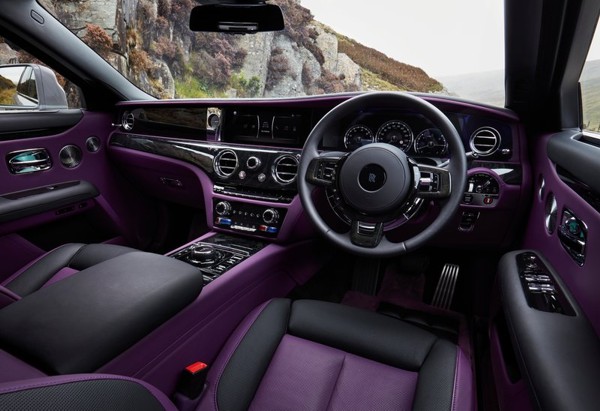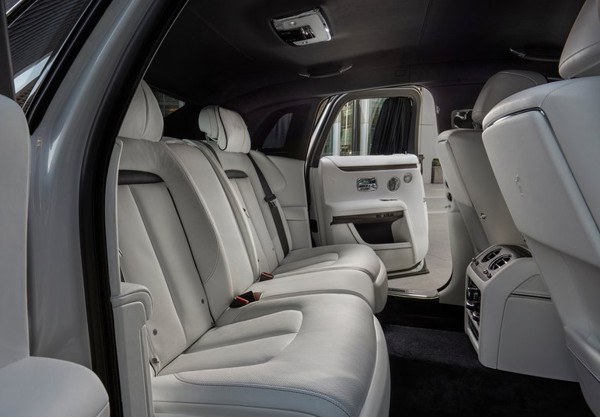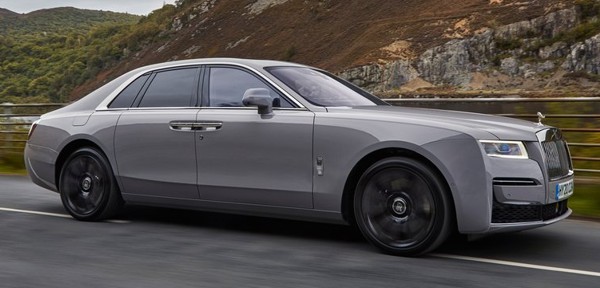| Published
on 1
Apr 2021 |
All rights reserved.
|
|
|

|
|
Rolls-Royce
calls this design theme "Post Opulence". I would call it "restrained
flamboyance".
|
|
More than 10 years have
gone since the launch of Ghost as the entry-level ("baby") RR. The last
Ghost was known to be the most popular model in the company's history.
The second generation car does not want to deviate from its principles.
It is still the entry-level Roller, with price starting at around
£250,000 at its home market, a third cheaper than the flagship
Phantom. While the Phantom is all about flamboyance, OTT and
customization, the Ghost sells for simplicity and purity. This can be
reflected from its exterior design, which is unusually free of crease
lines and panel gaps. In particular, the side of the car is a single
piece of uncluttered, slightly curved surface, with just a single edge
running at its very top end, linking neatly between the headlights and
taillights. The retractable Flying Lady statue is now mounted at a hole
through the bonnet instead of on the radiator grille, so that it
emphasizes the precision of assembly. The general body shape is
unchanged from the old car, but the design elements at the front just
get even squarer, no matter the waterfall grille, the headlights or the
bumper intake. Rolls-Royce calls this design theme "Post Opulence". I
would call it "restrained flamboyance".
Underneath lies a big departure from the old car though. Its chassis is
no longer a steel structure derived from BMW 7-Series, but an
all-aluminum spaceframe and body shell built on the platform of Phantom
and Cullinan SUV. In addition to the upcoming replacement for Wraith
and
Corniche, all Rolls-Royce models will be built on the same exclusive
platform. At 40,000 Nm/degree, its torsional rigidity is at the very
top of the game (matching the 2003 Phantom), giving it a strong
foundation for NVH suppression. Noise is cut further by using
double-skin bulkhead
and floor, with insulating material filled in between, by employing
double glazing windows and more than 100kg of sound deadening materials
throughout the cabin. Moreover, RR carefully tuned the frequency of the
remaining noises to be in harmony. It is expected to set new industrial
standards on cabin quietness.
 |
|
More
than 100kg of sound deadening materials are used throughout the cabin.
|
|
The new car is 5546mm long and 1978mm wide, exceeding its predecessor
by 89mm and 30mm, respectively. It is therefore significantly larger
than a Mercedes S-class, even Bentley Flying Spur. However, it is the
car's extra height, 88mm taller than the Bentley, and its very
high waist line that delivers a jumbo-size perception.
This is reflected also on scale, too. At 2490 kg, it is 130kg heavier
than its predecessor and 150kg more than the Flying Spur. Nevertheless,
the weight is 50:50 distributed between front and rear axle, thanks to
moving the front axle forward.
The engine is almost the same unit as that serving the Phantom. Now a
6.75-liter twin-turbo V12 (moan the recent demise of the true
6.75-liter Crewe V8), it produces the same 571hp as the Phantom as well
as its predecessor, but maximum torque bridges between them at 627
lbft, available from merely 1600 rpm. Transmission is again the famous
ZF 8-speed automatic, and it continues to hook up with GPS so that it
could pre-select the next gear for upcoming corners. What’s new is the
fitment of 4-wheel drive as standard, taken from Cullinan, so that it
can improve 0-60 mph sprint slightly to 4.6 seconds, even though a
Flying Spur W12 is way quicker at 3.4 ticks. Likewise, the Rolls is
limited to 155 mph, while the Bentley flats out at an astonishing 207
mph. The Rolls just rolls. The Flying Spur flies.

|
|
The
Rolls just rolls. The Flying Spur flies.
|
|
The suspension is
similar to those of Phantom and Cullinan as well, with double-wishbone
serving up front and 5-link setup at the rear, completed with
continuous adaptive dampers and height-adjustable adaptive air springs.
It also comes with the flagship model's magic carpet ride system, which
uses a 3D camera at the windscreen to scan the road surfaces ahead,
adjusting the suspension in advance. However, in the attempt to take
ride comfort to a new height, the Ghost introduces the world's first
upper wishbone dampers at the front suspension. It adds an extra damper
above the front suspension assembly.
As before, you can opt for an active anti-roll bar for the rear axle,
but this is an old design powered by 12V electrical system, so it won’t
be as powerful as the 48V system used on Bentley, Porsche or Audi.
Comparatively, the new 4-wheel steering system should be more effective
to make the big car feeling more agile than its size suggested,
especially turning in tighter spaces.
Inside, the Rolls-Royce is high on material quality and craftsmanship,
of course, but compared with the Phantom it is rather simple and
uncluttered. Maybe even a little understated. The most interesting new
feature is the starlight fascia located ahead of the front passenger
seat. It incorporates 90,000 tiny laser-drilled holes to illuminate LED
lighting, welcome you by flashing like galaxy when you enter the cabin,
and disappears out of sight afterwards. Retrained Flamboyance, again.

|
|
If
luxury means showing off your superior (seating) position, then it has
plenty.
|
|
On
the Road
From the moment you open the solid front door, step across the low sill
and sit on the high-set and upright driver seat, the experience is so
special yet so familiar to the customers of Rolls-Royce. Ditto the rear
seat, the most likely place its owners will spend time. You open the
rear hinged door, which is still unique to the brand, put your body
gracefully onto the deep-set chair. The view around is commanding – not
in terms of visibility, because the A, B and C-pillars are all very
thick, but you sit as high as a proper SUV, looking down to the road
and other cars. If luxury means showing off your superior position,
then it has plenty.
The same goes for space. Passengers of any size will find cabin space
aplenty, although you might expect even more from its exterior
dimensions. The second row of Ghost cannot accommodate airliner-style
reclining chairs, unlike a Mercedes-Maybach S-class, but you can have
that
in the EWB (Extended Wheelbase) version. Between the independent rear
chairs you can opt for wine cabinet with refrigerator.
No
matter front or back, you are surrounded with high-quality materials:
big and soft leather chairs, thick carpets, wood and leather trims
everywhere, lacquered panels, metal air vents, all feel rich and
impeccably built. The interior design is traditional, conservative
even, simpler and less flamboyant than Bentley, but it suits the target
customers of Rolls-Royce, which are usually older and more conservative
kind of people. It lacks the “Art Gallery” of the Phantom, but the
starlight roof and LED ambient lighting still delivers a classy feel.
And yes, you can opt for LED illumination on the waterfall radiator
front grille, so don’t think the Ghost lacks flamboyance.

|
|
Even
cruising at a steady 70 mph, it is incredibly hushed, quieter than
Bentley, quieter than Mercedes, and even Phantom.
|
|
The infotainment system is reskinned from BMW. Its
touchscreen and i-Drive rotary control work very well, while graphics
look crisped and response is quick.
The Ghost starts in the quietest manner. Running at idle, you can
hardly perceive the operation of the V12, because it is so smooth and
so quiet. Even cruising at a steady 70 mph, it is incredibly hushed,
quieter than Bentley, quieter than Mercedes, and even Phantom. The
effort Rolls-Royce spent to insulation and suppress noises have paid
off.
Few cars can be driven as relaxingly as the Ghost. You don’t ever look
at the rev counter, not only because it always provides plenty of
torque to meet your demand but also it doesn’t have a rev counter. You
don’t make gearshift either, because this is the only ZF 8HP
transmission that forgoes manual mode deliberately. You don’t need to
bother between Comfort and Sport mode either, since it provides
neither. If you must call, the Ghost has only one mode: Comfort. Sport
or Sport+ are just things living in another universe, let alone
ESC-Off. Nothing could be easier to drive as this car: you just give
the smooth throttle pedal a little bit pressure, turn the very light
yet precise steering wheel, watch rather than hear or feel the outside
world moving backward. The V12 turns like an electric motor and the
gearshift is smooth to the extent of imperceptible. The Ghost makes a
driving experience non-experience.

|
|
The
Ghost makes a driving experience non-experience.
|
|
The soft
suspension is competent to take on most surfaces. Bigger, slower bumps
are absorbed effortlessly. Undulations on motorway are smoothed out
like magic carpet. Only high-frequency irregularities might be felt and
heard in the cabin, something air suspensions not always good at
dealing with. The Ghost unquestionably rides smoother than Bentley
Flying Spur, though Mercedes S-class is probably more rounded.
Naturally, the combination of soft suspension, high center of gravity
and the lack of Sport mode means pronounced body roll. It is far from
alarming, as there is still adaptive dampers and active rear anti-roll
bar to take care of, but you are not encouraged to hustle the Ghost in
tighter corners. It will also run into understeer in such
circumstances. In faster bends, once the huge body settles on the soft
suspension, it turns more neutrally. However, even though it is
noticeably more agile than the Phantom, this is absolutely no driver’s
car. The body roll, the soft brakes, the lack of steering feel and
weight all limit its driver appeal.
So what? Rolls-Royce has never pretended to be a driver’s car in its
117-year history. When it wanted, it made use of the Bentley name.
Since the divorce from Bentley and went into the hands of BMW,
Rolls-Royce is happy with making the world’s most luxurious and
comfortable cars. Whether you like its bulky shape, its conservative
design or its under-par driver appeal, you have to admit that it
delivers luxury and comfort better than others, at least when cost is
not a concern.
|
Verdict:     |
|